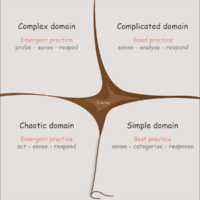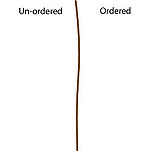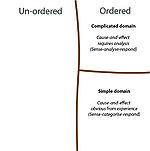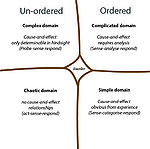The Cynefin Framework
This article will introduce the Cynefin framework and its underlying practices, which can be used for sense- and decision making in a complex and complicated world. [1] The framework is developed by David J. Snowden (born 1 April 1954)[2], and is used by leaders to determine operative context so they can make appropriate choices. The framework has been applied in multiple contexts, among them are strategy management, project management, research, policy making, leadership training, healthcare etc. [3]
The Cynefin framework splits the issues that faces leaders into five contexts; simple, complicated, complex, chaotic and disorder. Each of which requires different approaches to leadership style. [1][4]
Reflekter på hvordan det passer ind i APPPM
Contents |
History
The Cynefin model
The Cynefin framework distinguieshes between order, unorder and disorder.[5] It describes five contexts that leaders can use for categorizing operating contexts for making appropriate choices. Each context requires different action.[1] The simple and complicated domains assume an ordered universe, where decisions can be based on facts, right answers can be determined and there is a direct link between cause-and-effect. Whereas the complex and chaotic domains are unordered and deals with uncertainty, there is no direct link between cause-and-effect, and decisions and right answers is searched for in emerging patterns. In the the final domain disorder is hard to determine when one is in it. different leaders have different opinions, and the way out is to break the situation down to smaller parts and assign the each one to one of the four domains. [1]
Order:1. Simple contexts (known knowns)
The domain of best practice, known-knowns, here we know exactly what we are doing and we have done it before, so we sense, categorize and responds (S-C-R)[1][4]
2. Complicated contexts (known unknowns)
The domain where we do not know what is going on, but we know that we can analyse what has happened and figure it out. We are sense, analyse and responds (S-A-R)[1][4]
3. Complex contexts (unknown unknowns)
In the complex domain we can not determine what will be the outcome, but we can run some experiments and see if they will move us in the right direction. We probe, sense and respond (P-S-R).
In this domain we can only understand what is happening in hindsight [1].
4. Chaotic contexts (unknowable unknowns)
In this domain, the domain of unknowables, it does not make sense to search for answers, no patterns exist - only turbulence. We act (do something), we sense where stability emerges and then we respond by working towards complexity (A-S-R)[1][4].
Disorder (not determined)
These are the situations where one are yet to break down and determine where the situation belongs in the framework.[1][5]
Guide on leadership
Framework for decision making in multiple contexts[4][1]
Snowden states, that if you want to become effective as a leader, you must learn to shift your leadership style to match the changing business environments. The four different domains call for different leadership styles and managerial responses.
| Characteristics of context | The leaders job | Danger signals | Response to danger signals | |
| Simple |
-Known-Knowns, |
-S-C-R: Sense, Categorise, Respond, |
-Comfort, |
-Don't assume that things are simple, |
| Complicated |
-Known-unknowns, |
-S-A-R: Sense, Analyse, Respond, |
-Experts overconfident in their solutions or in past solutions, |
-Encourage internal and external stakeholders to challenge expert opinions and thinking, |
| Complex |
-Unknown-unknowns, |
-P-B-R: Probe, Sense, Respond, |
-Temptation to look for facts rather than allowing patterns to emerge, |
-Be patient and allow time for reflection, |
| Chaotic |
-Unknowable-unknowns, |
-A-S-R: Act, Sense, Respond, |
-Applying a command-and-control approach longer than needed, |
-Try to move the situation towards the complex domain, |
Perspective on organisational theory and paradigms
Ontology and ideology
In most current management practices, the ideology that seem to exist assumes that there is an underlying relationship between cause and effect, and predicts that the future can be planned by discovering these underlying relationships. Examples are case studies and consultancy frameworks, that rely on transferring best practices across companies and industries[6].
It is assumed that there is a right answer to problems/situations, and that failure hereof is a failure in analysis on the underlying causal relationships[4].
This ideology belongs to the modernist paradigm of organisational theory, where managers base their decisions mainly on descriptive measures and statistics[7]. This ideology of decision making is represented in the right hand side of The Cynefin Framework (the domain of order: simple and complicated).
When introduced to complex situations, former practitioners have relied on reductionistic scientific methods[8], which assumes that complex systems is nothing but a sum of its parts[9]. Managers have therefore made decisions by breaking down the situations into sub-parts and analysed each part individually, implying that the answer to the complex problem could be found in the sum of cause-and-effect relationships.
The method of reductionism is, however, contradicting with the ideology of decision making in complexity. When reductionist thinking asserts that we proceed when certain[9], complexity thinking enables us to proceed by probing that which always be uncertain[1].
The left hand side of the Cynefin Framework (complexity and chaos) therefore breaks with traditional modernistic decision making, by introducing sense- and decision making approaches in situations that does not have underlying causality and is therefore belonging in the post-modern paradigm, where there are no definite answer to situations and problems[7].
Examples of contexts
- Examples of simple contexts
- Examples of complicated contexts
- Examples of Complex contexts
- Examples of Chaotic contexts
- Examples of Disorder
Examples of uses
Cynefin used in projects
The Cynefin framework can be used in projects as a sense-making tool and as a common language for dealing with complexity[1][10]. When using the framework in project management, Snowden emphasizes using the framework as a collective sense-making method that allows specific patterns to emerge in the understanding of the project [10].
Snowden's idea with sense-making in projects is to provide a common understanding of language depending on the environment. Snowden claims that experts' language is too restricted and abstract for managing complexity in project work, and remains about the problem but still far above it[10]. Snowden therefore emphasizes the role of language in sense-making about complexity in projects and especially as a communicator to create meaningfull messages that are informative, comprehensive and not oversimplified [4][10].
- Cynefin used in Ergonomics
LEGO game
A game to let you experience four of the five domains of Dave Snowden’s Cynefin framework.
Using Lego, you go through four exercises where the problem to solve and the context you work in is designed to create a simple, complicated, complex and chaotic system. While it does not introduce you to the full potential of the sense-making framework, it is well suited to get a first impression and raise interest in learning more about it! Although Cynefin is at the heart of this excercise, the debriefing focuses on outcome that is not necessarily part of the model.
When leading or managing agile transitions, it is important to know what type of system you are dealing with. Playing this game shows you how to decode what is happening in terms of organisational structures and communication in that specific system. Once you are able to do this, you can appreciate the consistency of your communication style with the related system, as well as choose more appropriate tools to set direction and coach.
Timing
The game shouldn’t take more than 60 minutes.
Material and Environment
Tables for groups of three/four, about 200 bricks of Lego in 6-10 colours in different sizes with about 10% special bricks (flowers, wheels, ...) per table.
Instructions
Draw the diagram above on a flip chart. Only draw the lines in the middle, you will fill the diagram on the way (people should experience the four domains before conceptualising them with you).
You play one exercise for each of the domains, as described below. For each exercise:
- Explain the rules until there are no questions
- Start the exercise on all tables
- Track the time (but do not set a timebox)
- Capture smallest and largest time-to-completion
- When all teams are finished, give them 2 min for in-team reflection
- Share the findings, use debriefing questions.
- Draw the details for this domain on the flip chart and connect to the teams’ findings.
- Draw the communication structure and decision making structure observed during this exercise.
Exercise 1: Simple The Challenge “Sort the bricks into colours, as quickly as possible. Create one heap for all special pieces. Decide in your team which pieces you want to treat as special.”
Debriefing
- How much time did you need for planning?
- How was the communication? How many leaders/followers were in your team?
- You will notice that common Best Practices arise from different groups
- Analyse the communication structure and the way people took decision and agree on what to do, you should notice the Top-Down Communication pattern, where one person proposed “the” way of solving the problem and the others just followed. Not much peer-to-peer communication will be going on during the exercise, at least not about how to do things, but more operative.
Exercise 2: Complicated The Challenge Build a structure, as quickly as possible, according to the following rules:
- At least 20 bricks high
- Regular colour pattern
- Every new block that you add to the structure can’t be bigger than the one below it
Debriefing
- What felt different compared to the simple problem?
- How much time did you need for planning?
- How was the communication? How many leaders/followers were in your team?
- In this case you will notice that possibly every team adopted different practice, producing different results. There is no Best Practice but many Good Practices.
- Analyse the communication structure and the way people took decision and agree on what to do, you should notice the Expert Communication pattern, where everyone tried to propose a possible solution. Some teams at this point may enter in analysis-paralysis, consider this as an invitation to retrospect on the role of one member facilitating the group.
Exercise 3: Complex The Challenge “Decide in 30 seconds to build either an animal or a vehicle. After that you work according to the following rules:
- As in exercise 2, you need to create a regular colour pattern.
- Each colour of bricks must only be touched by one person in your team.
- You are not allowed to talk.
- Every minute, you need to switch tables, taking your unfinished work with you (but not the material).”
Debriefing
- What felt different compared to the simple/complicated problem?
- How was the communication? How many leaders/followers were in your team?
- What kind of feedback did you have to guide you towards a solution?
- Would it have made a difference if you had had five minutes to talk and plan before you started building?
- Here you should notice a clear emergent behaviour, many people end up surprised on how the ban of verbal communication—obviously it is a game—actually keeps them from entering long discussions, while the probing in building something together turned out to spark new ideas and inspiration at every step. Consider comparing the time with the previous exercise, normally it doesn’t differ too much, despite the fact that the challenge is complex.
Exercise 4: Chaotic The Challenge “Your task is similar to the last one, but now you need to create a building or a plant. At random times, the facilitator will touch a team member’s shoulder and indicate another table. That person then immediately joins a different team.”
They are still not allowed to talk. For a lost teammate they might get someone back, but not immediately. (That leads to them thinking they miss a person dealing with a certain colour, which is actually not true, if you read the rule. You do not tell them it is not true).
Debriefing
- What felt different compared to the complex problem/situation?
- How was the communication? How many leaders/followers were in your team?
- How did it feel to loose a team member? How to join another team?
- Why does this small change make such a big difference?
- Here you should be able to appreciate that communication was mostly inexistent after a while, that people gave up trying to communicate, they rather start doing and get stopped by others (Act and then Probe). In particular people will feel - as opposed to the previous exercise - completely demotivated and frustrated.
Notes
The simple exercise typically gets a quick and easy solution. One player suggests something obvious and the others follow.
The complicated exercise needs a bit of planning, typically everybody suggests something, a quick decision is made and process is adapted according to feedback during the build.
The complex exercise doesn’t get better with more planning. The right process emerges and is continually adapted. The sooner teams start to build, the sooner they feel comfortable. It helps if all team members know what the animal/vehicle they want to build actually looks like.
The chaotic exercise leads to quite surprising, sometimes not very good solutions (see the building without roof in the picture). People feel uncomfortable all the time, the solution takes longer than before. Especially for managers, this is an aha-experience: “So this is how it feels to change a team...”
Criticism
- Critical reviews of the Cynefin Framework
- Risk of oversimplifying the problems
Additional reading
- Article: Harvard business review: Snowden, David J., and Mary E. Boone. "A leader's framework for decision making." [1]
- Article: Snowden, Dave. "Strategy in the context of uncertainty." Handbook of Business strategy 6.1 (2005): 47-54. [4]
- Article: Hasan, Helen, and Alanah Kazlauskas. "The Cynefin framework: putting complexity into perspective." (2014): 55. [5]
- Article: Jarrar, Yasar F., and Mohamed Zairi. "Best practice transfer for future competitiveness: a study of best practices." Total Quality Management 11.4-6 (2000): 734-740. [6]
- Article: Browning, Larry, and Thierry Boudès. "The use of narrative to understand and respond to complexity: A comparative analysis of the Cynefin and Weickian models." E: CO 7.3-4 (2005): 32-39. [10]
- Article: Van Beurden, Eric K., et al. "Making sense in a complex landscape: how the Cynefin Framework from Complex Adaptive Systems Theory can inform health promotion practice." Health promotion international (2011): dar089. [3]
- Book: Hatch, Mary Jo. Organization theory: modern, symbolic and postmodern perspectives. Oxford university press, 2012. [7]
- About Dave J. Snowden: http://web.up.ac.za/default.asp?ipkCategoryID=5667[2]
- Cynefin 101, an article by Greg Brougham http://www.infoq.com/articles/cynefin-introduction
- The new dynamics of strategy: sense-making in a complex and complicated world http://alumni.media.mit.edu/~brooks/storybiz/kurtz.pdf
- Video: (Youtube): The Cynefin Framework http://www.youtube.com/watch?v=N7oz366X0-8
- Article archive: cognitive-edge.com http://cognitive-edge.com/library/more/articles/
- Article: 'Cynefin Centre: Life after IBM' 2005, KM World, 14, 7, pp. 1-26, Business Source Premier, EBSCOhost, viewed 14 November 2014.
- Article: Elford, W. (2012). A multi-ontology view of ergonomics: applying the Cynefin Framework to improve theory and practice. Work, 41, 812.[8]
- Definition of reductionism: Interdisciplinary Encyclopedia of Religion and Science ISSN: 2037-2329 [9]
Bibliography
- ↑ 1.00 1.01 1.02 1.03 1.04 1.05 1.06 1.07 1.08 1.09 1.10 1.11 1.12 Snowden, David J., and Mary E. Boone. "A leader's framework for decision making." harvard business review 85.11 (2007): 68.
- ↑ 2.0 2.1 University of Van Pretoria, 2014
- ↑ 3.0 3.1 Van Beurden, Eric K., et al. "Making sense in a complex landscape: how the Cynefin Framework from Complex Adaptive Systems Theory can inform health promotion practice." Health promotion international (2011): dar089.
- ↑ 4.0 4.1 4.2 4.3 4.4 4.5 4.6 4.7 Snowden, Dave. "Strategy in the context of uncertainty." Handbook of Business strategy 6.1 (2005): 47-54.
- ↑ 5.0 5.1 5.2 Hasan, Helen, and Alanah Kazlauskas. "The Cynefin framework: putting complexity into perspective." (2014): 55.
- ↑ 6.0 6.1 Jarrar, Yasar F., and Mohamed Zairi. "Best practice transfer for future competitiveness: a study of best practices." Total Quality Management 11.4-6 (2000): 734-740.
- ↑ 7.0 7.1 7.2 Hatch, Mary Jo. Organization theory: modern, symbolic and postmodern perspectives. Oxford university press, 2012.
- ↑ 8.0 8.1 Elford, W. (2012). A multi-ontology view of ergonomics: applying the Cynefin Framework to improve theory and practice. Work, 41, 812.
- ↑ 9.0 9.1 9.2 Interdisciplinary Encyclopedia of Religion and Science ISSN: 2037-2329
- ↑ 10.0 10.1 10.2 10.3 10.4 Browning, Larry, and Thierry Boudès. "The use of narrative to understand and respond to complexity: A comparative analysis of the Cynefin and Weickian models." E: CO 7.3-4 (2005): 32-39.



